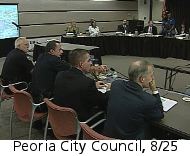9/2/2009
Arizona: Peoria Cameras Increased AccidentsAccidents increased after red light cameras used in Peoria, Arizona. Longer yellows cut violations 42 percent.

The number of traffic accidents doubled at locations where red light cameras were installed in Peoria, Arizona, according to data released last week at a city council study session. City data also indicate that more recent changes in intersection yellow timing have reduced the number of red light violations.
So far, the financial impact of the program has been substantial. On January 31, 2008, the city authorized an Australian company, Redflex Traffic Systems, to issue automated traffic violations at four city intersections. As of June 30, 2009, Redflex had mailed 25,706 citations worth $5,501,084.
A before and after comparison of two year's worth of accident data -- from July 2007 to June 2008 compared to July 2008 to June 2009 -- proved to be far less positive. The data are somewhat clouded by an overlap of a few months of ticketing in the 'before' period chosen by the city. In addition, the 'after' period also includes a few months in which the duration of yellow warning times increased by a half-second at three of four intersections. The timing change was made as an experiment on March 1, 2009.
"The engineering department agreed to go back and review our yellow light timing, especially at the red light camera intersections, to determine if they were as effective as they could be," Engineering Director Andy Granger explained. "We just wanted to increase it a half-second to see what the impacts would be."
Despite the data limitations, the intersection-by-intersection results were significant.Taken together, accidents increased a total of 103 percent at all four intersections. This result is consistent with the findings of a number of independent studies on the effect of photo enforcement (view studies). At the three intersections with yellow light increases violations dropped an average of 42 percent. Peoria officials got the message about the importance of yellow timing.
- At 91st Avenue and Bell road, accidents increased 100 percent, including a 120 percent jump in rear end and "stopped for red light" collisions, in the year after red light cameras were installed. In the four months after the yellow light was increased from 4.0 to 4.5 seconds, violations immediately dropped 80 percent on the eastbound approach and 70 percent westbound.
- At 75th Avenue and Thunderbird Road, accidents increased 480 percent. The number of right-angle and head-on collisions increased from 4 to 20, while rear-end collisions also jumped 400 percent. After the yellow light was increased from 4.0 to 4.5 seconds, violations decreased 45 percent eastbound and 26 percent northbound.
- At 83rd Avenue and Union Hills, where only left turns are monitored by cameras, accidents increased just 11 percent. The yellow light increase from 3.0 seconds to 3.5 seconds yielded an immediate 57 percent drop in violations.
- At 83rd Avenue and Thunderbird Road, accidents increased 29 percent, including a 300 percent jump in rear-end collisions. This location serves as a control intersection for considering the effects of not increasing the yellow duration. Unlike the three other locations, violations increased 111 percent at this intersection where the signal timing remained unchanged at 4.5 seconds.
"You can see there is a significant decrease in the violations," Granger said. "It is a big impact."
Beginning this week, the protected yellow phase at every intersection in the city will rise to 4.0 seconds. This stands in contrast to neighboring cities like Glendale and Scottsdale which cling to short, 3.0 second yellow times for all left-hand turns -- the bare minimum amount permitted under federal regulations.
Despite the evidence from 83rd Avenue and Thunderbird, Granger insisted that the cameras should share the credit for the reduction in violations. Police Commander Doug Hildebrandt likewise asserted that red light cameras were not responsible for the significant increase in the number of accidents. Instead, he blamed construction in Glendale for pushing traffic onto Peoria streets. Councilman Ron Aames questioned this rosy analysis of the cameras' performance.
"It makes me think, before we had the red light cameras we had noticeably less collisions than we have now with the red light cameras," Aames said. "A lot of the (accident columns) before we had the red light cameras were zero, zero, zero. Now we are seeing accidents. I thought we were doing this test to see if it was going to reduce accidents."
Deputy City Manager Susan K. Thorpe interrupted to make the point that the accident numbers were dynamic and include a number of different variables. With a limited amount of data, it is not possible to isolate a single cause.
"I'm thinking if these numbers were reversed and in the prior period we had 73 and in the current period with the red light cameras we had 36, I probably wouldn't hear these other ways of explaining it. I would probably hear, 'The red light cameras did their job.'"
In 1991, residents voted by a two-to-one margin to oust a photo radar program from Peoria. The city council ignored the expressed sentiment toward photo enforcement in re-imposing automated ticketing.
A copy of the Peoria data is available in a 360k PDF file at the source link below.


